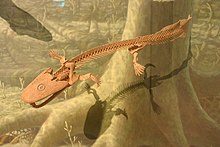Acanthostega
| Acanthostega | |
|---|---|

| |
| Skeletal reconstruction | |
| Scientific classification | |
| Domain: | Eukaryota |
| Kingdom: | Animalia |
| Phylum: | Chordata |
| Clade: | Sarcopterygii |
| Clade: | Tetrapodomorpha |
| Clade: | Stegocephali |
| Family: | †Acanthostegidae Jarvik, 1952 |
| Genus: | †Acanthostega Jarvik, 1952 |
| Species: | †A. gunnari
|
| Binomial name | |
| †Acanthostega gunnari Jarvik, 1952
| |
Acanthostega (meaning "spiny roof") is an extinct genus of
Discovery
The
Description
The 60 cm (24 in) Acanthostega
There are many morphological changes that allowed the pelvic girdle of Acanthostega to become a weight-bearing structure. In more ancestral states the two sides of the girdle were not attached. In Acanthostega there is contact between the two sides and fusion of the girdle with the sacral rib of the vertebral column. These fusions would have made the pelvic region more powerful and equipped to counter the force of gravity when not supported by the buoyancy of an aquatic environment.[4] It had internal gills that were covered like those of fish. It also had lungs, but its ribs were too short to support its chest cavity out of water.[2]
Classification

Acanthostega is seen as part of widespread evolutionary radiation in the late Devonian period, starting with purely aquatic finned tetrapodomorphs, with their successors showing increased air-breathing capability and related adaptions to the jaws and gills, as well as more muscular neck allowing freer movement of the head than fish have, and use of the fins to raise the body of the fish.[2] These features are displayed by the earlier Tiktaalik, which like Ichthyostega showed signs of greater abilities to move around on land, but is thought to have been primarily aquatic.[2]
In
Paleobiology
Hunting strategy
It has been inferred that Acanthostega probably lived in shallow, weed-choked swamps, its legs apparently being adapted for these specific ecosystems. Apart from the presence of limbs, it was not adapted in any way for walking on land.

Research based on analysis of the
Lifestyle

While normally considered more basal than Ichthyostega, it is possible that Acanthostega was actually more derived. Since Acanthostega resembles juvenile Ichthyostega and shows a lot less differences from juveniles to adults than the latter, it has been suggested that Acanthostega might be descended from a neotenic lineage. Although it appears to have spent its whole life in water, its humerus also exhibits traits that resemble those of later, fully terrestrial stem-tetrapods (the humerus in Ichthyostega being somewhat derived from, and homologous with the pectoral and pelvic fin bones of earlier fishes). This could indicate that vertebrates evolved terrestrial traits earlier than previously assumed, and numerous times independently from another.[6] Muscle scars on the forelimbs of Acanthostega were similar to those of crown-tetrapods, suggesting that it evolved from an ancestor that had more terrestrial adaptations than itself.[7]
Development
A
See also
Sources
- ^ Benton, Michael J. (2019). "Acanthostega". Vertebrate Palaeontology (Kindle ed.). Wiley. p. 90.
- ^ a b c d e [1] Archived February 25, 2007, at the Wayback Machine
- ^ "Acanthostega gunneri". Devonian Times. Retrieved 2013-11-04.
- ^ S2CID 4412211.
- PMID 17438285.
- ^ Fossils suggest earlier land-water transition of tetrapod
- S2CID 28461841.
- PMID 27602519.
Sources
- Boisvert, C. A. (2005). "The pelvic fin and girdle of Panderichthys and the origin of tetrapod locomotion". Nature. 438 (7071): 1145–1147. S2CID 4412211.
- Clack, J. A. (2006). "The emergence of early tetrapods". Palaeogeography, Palaeoclimatology, Palaeoecology. 232 (2–4): 167–189. .
- Clack, J. A. (2009). "The fin to limb transition: new data, interpretations, and hypotheses from paleontology and developmental biology". Annual Review of Earth and Planetary Sciences. 37 (1): 163–179. .
- Laurin M. 2010. How Vertebrates Left the Water. Berkeley: University of California Press.
- Steyer J-Sb. 2012. Earth Before the Dinosaurs. Bloomington: Indiana University Press.
